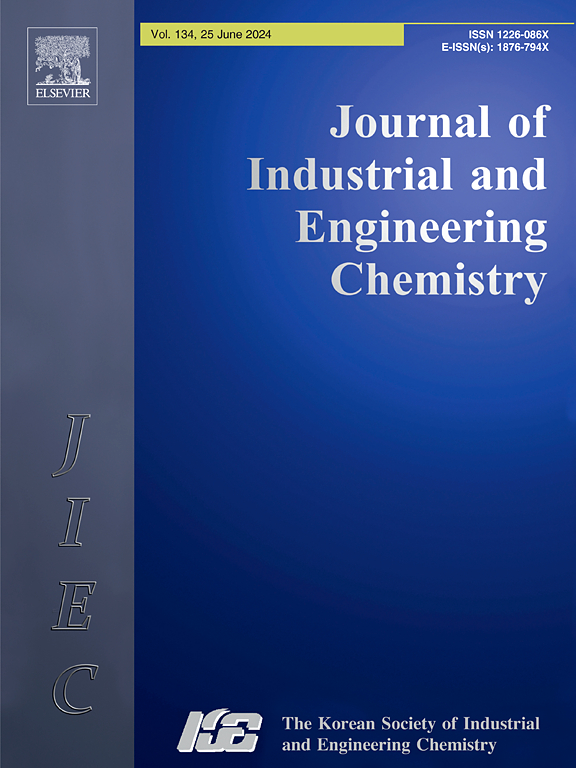Sustainable water treatment using agricultural residue Adsorbents: Evaluating Efficacy and life cycle impacts
IF 5.9
3区 工程技术
Q1 CHEMISTRY, MULTIDISCIPLINARY
Journal of Industrial and Engineering Chemistry
Pub Date : 2025-02-22
DOI:10.1016/j.jiec.2025.02.047
引用次数: 0
Abstract
This study evaluated an agricultural residue-derived adsorbent (ARA), optimized at a pyrolysis temperature of 840 °C, for its adsorption efficiency, water treatment potential and environmental sustainability. The ARA featured a large surface area (520 m2/g), well-developed micro/mesopores, and functionalized surfaces, enabling rapid and effective removal of organic water contaminants through π–π electron donor–acceptor interactions. Its adsorption performance with a Qmax of 6.17 mg/g against humic acid, was comparable to that of widely used commercial activated carbons (ACs). Life cycle assessment, based on adsorption capacity as the functional unit, revealed ARA’s superior environmental profile with a 22 % less global warming potential compared to conventional coal-based AC. The ARA demonstrated carbon–neutral and eco-friendly properties across ten TRACI impact categories, which includes acidification, eutrophication, ecotoxicity, fossil fuel depletion and human health risks. Sensitivity analysis identified activation processes and electricity consumption as critical contributors to environmental impacts, emphasizing the importance of optimizing production processes and incorporating renewable energy sources. These findings highlight ARA’s potential as a sustainable, green alternative to fossil-fuel-derived adsorbents. Beyond its high adsorption performance, the material aligns with global efforts to reduce the environmental footprint of water treatment technologies, and the results of this study support a paradigm shift toward integrating operational efficiency and environmental sustainability into adsorbent design.

利用农业残留物吸附剂的可持续水处理:评估效果和生命周期影响
研究了在840℃热解条件下优化的农用渣滓吸附剂(ARA)的吸附效率、水处理潜力和环境可持续性。ARA具有大表面积(520 m2/g),发育良好的微/介孔和功能化表面,能够通过π -π电子供体-受体相互作用快速有效地去除有机水污染物。活性炭对腐植酸的最大吸附量(Qmax)为6.17 mg/g,与市面上广泛使用的活性炭相当。基于吸附能力作为功能单位的生命周期评估显示,与传统煤基AC相比,ARA具有卓越的环境特征,全球变暖潜能值降低22%。ARA在10个TRACI影响类别中表现出碳中性和环保特性,包括酸化、富营养化、生态毒性、化石燃料枯竭和人类健康风险。敏感性分析确定了激活过程和电力消耗是环境影响的关键因素,强调了优化生产过程和纳入可再生能源的重要性。这些发现突出了ARA作为化石燃料衍生吸附剂的可持续、绿色替代品的潜力。除了其高吸附性能外,该材料还符合全球减少水处理技术对环境影响的努力,本研究的结果支持将操作效率和环境可持续性整合到吸附剂设计中的范式转变。
本文章由计算机程序翻译,如有差异,请以英文原文为准。
求助全文
约1分钟内获得全文
求助全文
来源期刊
CiteScore
10.40
自引率
6.60%
发文量
639
审稿时长
29 days
期刊介绍:
Journal of Industrial and Engineering Chemistry is published monthly in English by the Korean Society of Industrial and Engineering Chemistry. JIEC brings together multidisciplinary interests in one journal and is to disseminate information on all aspects of research and development in industrial and engineering chemistry. Contributions in the form of research articles, short communications, notes and reviews are considered for publication. The editors welcome original contributions that have not been and are not to be published elsewhere. Instruction to authors and a manuscript submissions form are printed at the end of each issue. Bulk reprints of individual articles can be ordered. This publication is partially supported by Korea Research Foundation and the Korean Federation of Science and Technology Societies.

 求助内容:
求助内容: 应助结果提醒方式:
应助结果提醒方式:


